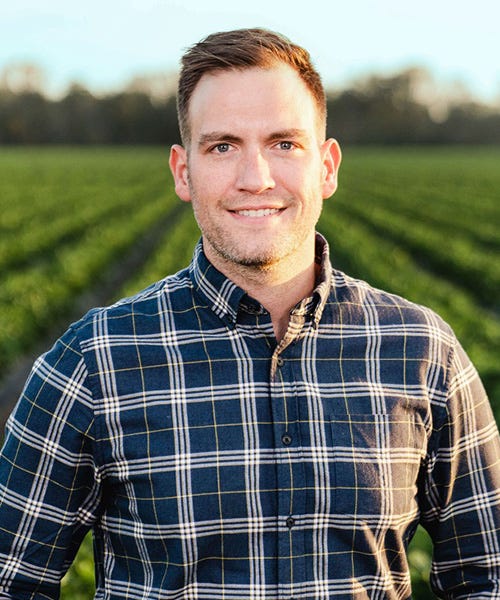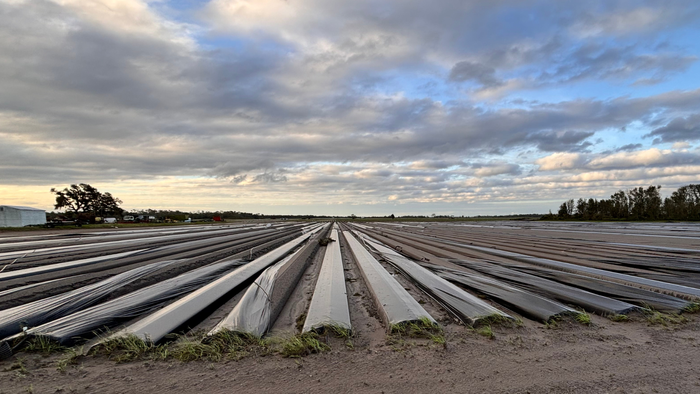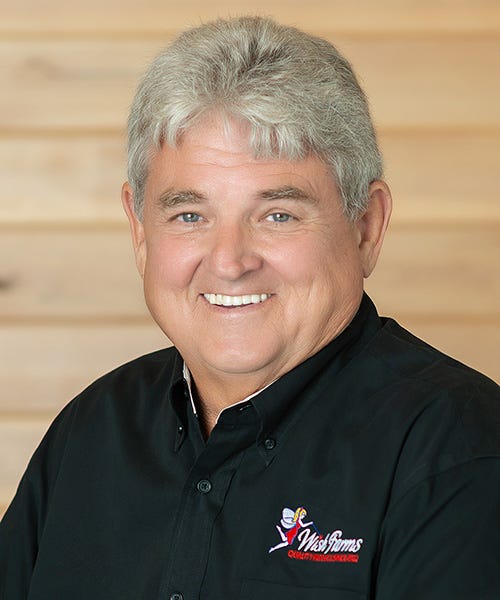Organic strawberry farms face additional challenges after Hurricane Milton
Organic farming methods leave strawberries more susceptible to fungal diseases than conventional plants, which could affect yield and margins. See how Florida’s Wish Farms is recovering.
November 26, 2024

At a Glance
- With an estimated 15,000 acres of strawberry fields, Florida is known as the “Winter Strawberry Capital of the World.”
- Planted fields survived the storm better than areas that weren’t yet planted, Wish Farms’ growers found.
- High-quality plants and crops that were saved are signs that supply chains and retailers will enjoy a strong recovery.
Farmers are resilient. But waiting to discover the aftermath of a hurricane can be arduous.
“It’s a lot of praying and crossing your fingers, hoping for the best,” says Nick Wishnatzki, public relations manager at Wish Farms, a fourth-generation, family-operated berry grower and shipper headquartered in Plant City, Florida. “It's more about the assessment and what needs to be done afterward to get everything back up and running. That’s the part that was so critical.”
In the wake of Hurricane Milton, a Category 3 storm that left a path of destruction across Florida on Oct. 9, many companies like Wish Farms grappled with what to do next.
“We tied everything down that we could, but there isn’t a ton of things to do except wait and hope that everything turns out OK,” Wishnatzki says. “You put large equipment away and whatever else you can to keep it shielded from any debris, but you’re just at the mercy of Mother Nature.”

Nick Wishnatzki, public relations manager at Wish Farms in Florida.
Hurricane Milton barreled through with more than 100-mile-per-hour winds and torrential rain. It ripped up plastic beds and drip tape used for irrigation and fertigation (fertilizing through a drip irrigation system), and flung a 20-foot tall, 11,500-gallon tank nearly a mile into the nearby forest as the storm raced through Manatee County.
“It’s the first time in so many decades that a storm has really affected the strawberry industry here,” Wishnatzki says. “It was a one-two punch with the rain and the wind because some fields were flooded for weeks and weren’t accessible to fix. Some had to be abandoned altogether.”
Wish Farms is far from alone. The Florida Department of Agriculture and Consumer Services’ initial damage assessment estimates total losses to the agriculture industry between $1.5 billion and $2.5 billion.
"Hurricane Milton has left a broad path of devastation, impacting our farmers and threatening Florida’s position as a leading agricultural producer,” Florida Commissioner of Agriculture Wilton Simpson said in a statement. “With four major hurricanes in just over a year, our agriculture communities have been hit repeatedly, causing unprecedented financial strain."

Hurricane Milton tore plastic coverings from Wish Farms' planted strawberry plants, pictured here on Oct. 10, 2024. Credit: Wish Farms
Assessing Milton's aftermath
In Florida, about half the year is hurricane season, which officially runs from June 1 until Nov. 30.
Florida is the second-largest producer of strawberries in the U.S., after California, with 14,200 acres of strawberry fields in 2023, according to the U.S. Department of Agriculture’s National Agricultural Statistics Service. This year, that acreage increased to approximately 15,000 acres, according to Florida Strawberries Growers Association. Wishnatzki estimates at least 15% of the state’s strawberry production falls within Wish Farms’ purview.
The brand’s flagship operation, G&D Farms in Duette, Florida, is the largest contiguous strawberry production in North America, according to the company. That currently includes approximately 2,400 acres under management at G&D Farms, with 700 acres of strawberries planted this year, says Wishnatzki. About 113 acres are organic.
Wish Farms, which operates as a grower and shipper, also represents local independent growers as a produce marketer for another 1,500 acres in Plant City and Dover, Florida. “We have marketing deals with local, independent growers,” Wishnatzki says. “We're the selling agent for those growers. They pack their fruit in our labeled clam shells, and then we sell it to the retailer.”
After Hurricane Helene hit Perry, Florida, in North Florida as a Category 4 hurricane on Sept. 26, Hurricane Milton made landfall two weeks later in Siesta Key, Florida, about 34 miles from Duette, Florida, as the crow flies. “Almost half of our farm was planted before the storm hit,” Wishnatzki says. “And the parts that were planted actually fared better than the parts that weren’t.”
As soon as it was safe to do so, Wishnatzki says G&D’s farm manager and team assessed the damage: Plastic from ripped-up beds lay scattered across unplanted fields that had just been prepped. In fields that were fixable, workers again tucked the plastic around the existing beds. In other spots, a bed presser created raised, graded rows in strawberry fields. The severity of the damage depended in part on how quickly the flooded fields dried out, assessed and repaired. You can repair wind damage pretty quickly, but waterlogged fields take much longer, says

Chuck Hollenkamp, executive vice president of Wishnatzki Farms.
“We got 14 to 16 inches of rain in some of these fields,” Hollenkamp says. “Water stood in those fields and plants sat in that water for a week or 10 days before the water receded.”
After the fields dried out, one of the biggest challenges was getting the beds re-set and plants planted in time. “If you’re caught coming in too late, you’ll miss the bigger, early money,” Hollenkamp says. “What you have left is the volume at lower prices. I’ve always said, ‘I’d rather pick less berries and have more money, than more berries and less money,’ because you have less labor, less packaging materials. The expense ratio is so different. Give me half the berries and twice the money as opposed to twice the berries and half the money.”
Organic methods more at risk
While a field of “regular” conventional strawberries might yield 3,000 flats to an acre, Hollenkamp says, if you’re lucky, you get 1,400 flats to an acre with organics. That’s coupled with higher input costs.
“Quite frankly, we do organics because we have a certain demand for them, but we don't make a lot of money on them,” Hollenkamp says. “It’s not a high profitable item. More profits are going to be in the conventional berries where they’re mass purchased all over the world.”
One of the challenges with growing organic strawberries has been the fungal disease pestalotia, formally known as neopestalotiopsis, Wishnatzki says.
“That really makes it really tough to grow organics, especially in Florida,” Wishnatzki says. Even though pestalotia is an industry-wide problem, the bigger problem is that it spreads when it's wet conditions. “So, the key is to keep the fields dry and keep the plants really clean.”
That’s harder to do after a hurricane. Conventional fields spray chemicals for pests like spider mites, chilli thrips and angular leaf spot. “Hurricane or no hurricane you still have to deal with all those things,” Hollenkamp says. “Organic is a whole other program, because you can't use all those things. You’ve got to use fish oil extracts and all that very expensive stuff.”
Still, some of the organic practices are being transferred over to the conventional fields. That’s happened with the use of predator mites, “the good mites” that eat the larvae of “bad mite” pests before they damage leaves of berry plants. “The predator mites come in little bottles, and you sprinkle them around your field and they will eat all the larvae,” Hollenkamp says.
“Because we're organic growers, we’ve used practices we have in the organic field in the conventional field,” Wishnatzki says. “There are things like predator mites that we do on the conventional side are used because we were using them in the organic fields and saw that they were effective.”
Rebuilding strawberry fields
In Florida, most strawberries are planted between October and early November to be harvested starting in December.
“The thing about berries is you have to pick a plant every three days,” Wishnatzki says. “So, you don't have a choice, whenever the crop comes in you've got to pick it because if you don't harvest those berries, the plant will die.”
In the fields that were already planted, about 80 field workers, many employed under the H-2A visa program for temporary agricultural employment of foreign workers, tried to salvage what they could. “They're working seven days a week to get that work done because you want to get done as quickly as you possibly can and get the growing part of the process started again,” Hollenkamp says.
To save plants, workers pulled new plastic over the top of the top of the plants, cut a hole and dug the plants back out of the hole, Hollenkamp says. “All in like an hour-and-a-half, two-hour period,” he adds. “That way, the plants got new plastic under them, the beds were formed properly and plants were planted.”
The labor-intensive process requires a lot of migrant workers to harvest the strawberry fields. “The biggest problem is the labor it takes to do that,” Hollenkamp says. “You’ve got to put so much labor in, just in the guys doing the work, the new plastic material. It's very, very expensive to do that work. But to save your profits, to get the yields, you’ve got to do everything you can to save it.”
Sometimes there weren’t enough people to work the field. Families had to step in, Wishnatzki says, working day and night because their livelihood depends on it. “It just speaks to the resilience of the farmer, especially the ones we were working with,” he says.
“You have folks out there that were tirelessly working to get everything back up and running,” Wishnatzki says. “I think because of that, we're going to have a strawberry season. We're very thankful that it wasn't worse.”
Despite the hurricane damage, Hollenkamp expects it will be a “very good season” for a couple of reasons. “The health of the plants that we received from California, North Carolina, Idaho, Canada, were the healthiest plants we've seen in years. We have a very good, healthy plant crop and that's the start of a good season.”
Another reason Hollenkamp anticipates it will be a good strawberry season: A lot of acres of farmland were saved.
“They'll be a little late on some of the acres, but half the crop is going to come in right on time,” Hollenkamp says. “We feel really good about this season, as far as getting our yields, as far as getting the quality of the product. You wouldn't think so if you saw the fields, like I did after the hurricane, but I think it's going to be a winner this year.”
Read more about:
OrganicAbout the Author
You May Also Like





